Top AI Visibility Tools in 2026
Noticed your traffic dropping even though your rankings look stable? You’re not alone.
AI tools like ChatGPT, Perplexity, and Google’s AI Overviews are now answering the same questions that used to send people to your site.
If your brand isn’t showing up in those AI-generated responses, you may be losing visibility. And the tough part? You won’t be able to measure that lost visibility with traditional analytics tools.
That’s where AI visibility tools come in. They tell you when your brand shows up in AI answers, which platforms mention you, and how often your content gets cited. In short, they track your presence across large language models (LLMs) and AI search engines so you know if your LLM seeding efforts are paying off.
The good news is a handful of tools are already helping brands track their AI visibility. Some existing platforms have added AI tracking to their SEO suites. Others focus exclusively on LLM citations.
Each gives a different way to see (and improve) your AI presence. Let’s look at some of the best AI visibility tools available right now.
The way people search is fundamentally changing. Gartner predicts traditional search engine volume will drop 25 percent by 2026 due to AI platform and virtual agent usage.
This is the zero-click phenomenon at work.
People are getting answers directly from AI platforms instead of clicking through to websites. That makes knowing where your brand appears in AI responses as vital as tracking your Google rankings.
AI visibility tools solve a measurement problem. They monitor which LLM platforms cite your content and your brand mentions in AI Overviews. They measure changes over time so you can evaluate whether your LLM SEO efforts are actually working.
Think of these tools as Google Analytics for AI search. Without this data, you’re guessing about what resonates with AI platforms. With it, you see exactly what content drives citations and what gets ignored. These tools reveal patterns in what content formats, topics, and structures earn the most AI citations.
Traditional SEO metrics like page views, rankings, and backlinks still matter. But they tell only part of the story.
Don’t ignore the growing segment of your audience interacting with your content through AI platforms. They might not visit your site, but their interactions still influence visibility and authority.
Combining standard analytics with AI visibility data shows the complete picture of your content’s reach and what’s actually driving results across channels.
The LLM visibility tool market is growing fast. New platforms launch regularly with different features, tracking methods, and pricing structures.
After comparing what’s out there, these five AI visibility tools stand out. They range from budget-friendly all-in-one platforms to enterprise-focused citation intelligence.
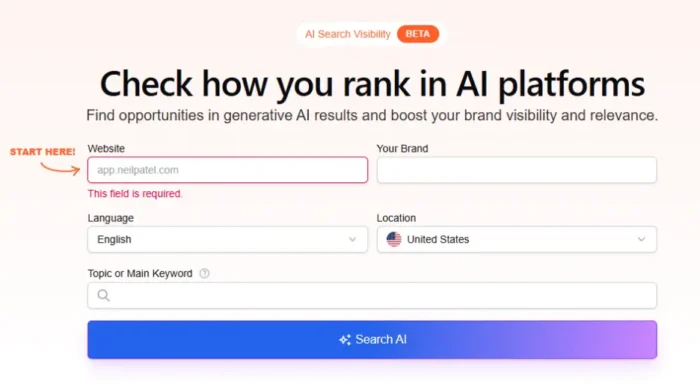
Ubersuggest has added new AI Visibility features to its SEO toolkit. The big win? You can now monitor AI citations and see how they connect to your traditional search performance, all from one dashboard.
Ubersuggest AI Visibility makes it easy to add AI visibility tracking into your marketing program. Key metrics the tool tracks include:
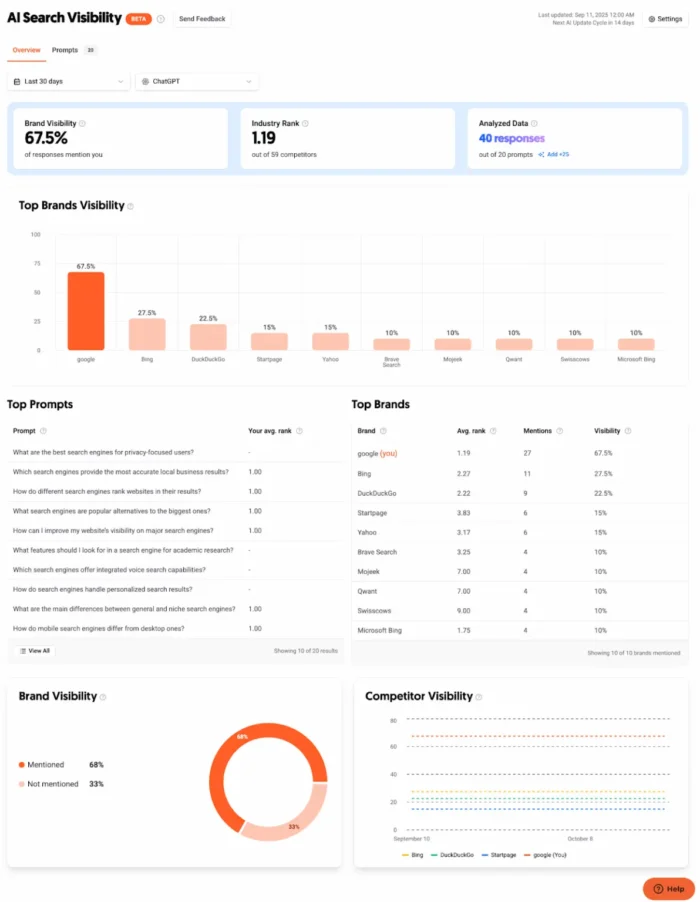
Along with the easy-to-navigate interface, Ubersuggest’s pricing is a major advantage. Most enterprise tools charge per project or lock you into long-term contracts. Ubersuggest takes a different route with flat monthly pricing and unlimited project tracking. That means an agency managing 20 clients pays the same as someone tracking just two sites.
You also get full access to all the traditional SEO features Ubersuggest is known for, so you don’t have to pay for two separate platforms to see the full picture.
Because Ubersuggest is built on years of SEO infrastructure, its data is consistent and reliable. And some teams might not be comfortable with other new visibility tools, many of which launched in the past year and are still working out bugs in their tracking.
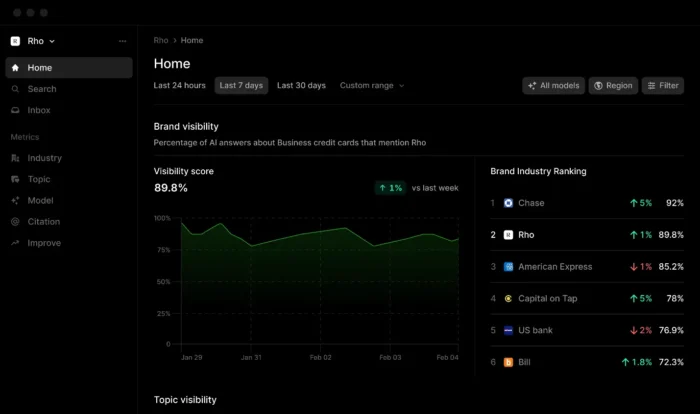
(Image Source)
Profound is a new platform specifically designed for enterprise brands that need detailed intelligence about how AI platforms discuss them. This goes beyond counting citations.
The system analyzes the context around every brand mention, including:
Profound is built for customization. Its team builds dashboards tailored to your industry, integrates with your existing systems, and creates reporting formats that match your organization’s workflow.
Need specialized tracking for regulated industries? They configure it. Competitive intelligence can also be scaled across hundreds of queries, and alert systems can let you know if your brand suddenly drops from an AI response.
The tradeoff? Price. Annual contract costs typically start high and scale based on how many brands you track, query volume, and customization needs. This isn’t built for small businesses.
With that said, Profound’s depth and customization justify the cost for brands where AI visibility directly impacts market position and revenue.
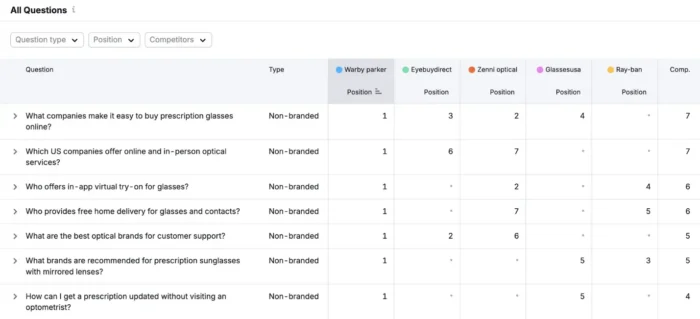
(Image Source)
Semrush added AI visibility tracking to its existing SEO suite. Already using the platform? The new features integrate smoothly into your workflow.
The tool monitors citations across major AI platforms and provides visibility scoring that works like domain authority, providing a single number showing how your AI presence compares to competitors over time.
The real benefit of Semrush’s functionality is that it connects AI visibility data with everything else it already tracks. You can see which pages earn both backlinks and AI citations. You can see whether content that ranks in traditional search also appears in AI responses. That integrated view helps you understand what’s working across all your marketing channels.
For teams trying to consolidate tools, this setup is efficient. You get traditional SEO and AI visibility data in one report, no platform-switching required.
The tradeoff is its agency pricing. Semrush limits how many projects you can track per account tier. Adding clients means upgrading plans or buying additional accounts. Managing 30-plus brands? Costs climb fast compared to platforms with unlimited project tracking.
Overall, this may be a smart add-on if you are already onboarded onto Semrush. But it might not be the most affordable option for smaller teams or tighter budgets.
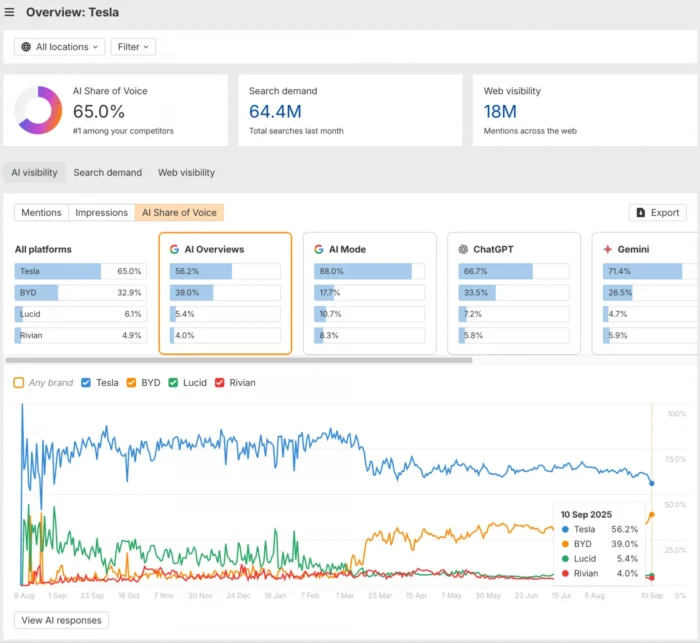
(Image Source)
Ahrefs made its name with backlink analysis and competitive research before becoming one of the most popular SEO tools around. Its move into AI visibility adds another layer to an already powerful platform.
This new functionality tracks citations across AI platforms and lets you filter by specific engines, monitor changes over time, and compare your visibility to competitors. Standard stuff.
Ahrefs stands out by connecting link data with AI citations. Its backlink index is one of the largest available and updates frequently. The platform shows correlations between your link profile and AI visibility, revealing which linked pages get cited most often in AI responses.
That connection offers real insight. Content earning quality backlinks tends to appear more in AI citations. Understanding that relationship helps you identify what makes content citation-worthy and apply those patterns to other pieces. Combine that with Ahrefs’ broader SEO features, and you get a well-rounded picture of your brand visibility online.
The major caveat, though, is the pricing, which follows a similar structure as Semrush. Plans limit tracked projects, so costs increase as you scale. Five clients work fine. Fifty clients get expensive.
For teams that prioritize link building alongside AI visibility, Ahrefs handles both well. Just know you’ll pay premium prices.
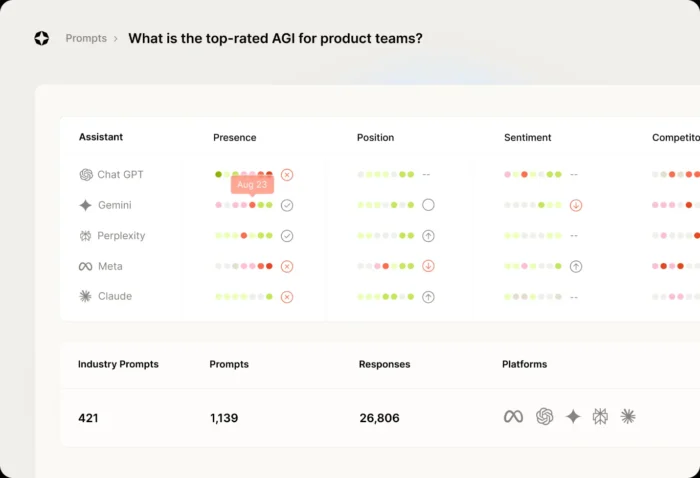
(Image Source)
ScrunchAI is a newer offering that focuses exclusively on AI visibility. Already using other tools for standard optimization and just need LLM citation tracking? Scrunch’s specialized approach might fit.
The platform monitors brand appearances across ChatGPT, Claude, Perplexity, Google’s AI Overviews, Bing AI, and emerging AI search engines. Real-time tracking alerts you to citation frequency changes, new platforms surfacing your content, or sudden visibility drops.
Where ScrunchAI stands out is that it tracks both citation quality and frequency. It can tell whether AI platforms position your brand as a primary resource, secondary resource, and if any misinformation shows up alongside your name.
ScrunchAI also provides recommendations based on your data. Certain content structures get cited more often? It suggests creating similar pieces. Missing from responses where competitors appear? It flags those gaps with specific topic ideas.
Another interesting feature is query simulation. You can run industry-specific prompts to see if your brand appears and compare results across different AI engines. That gives you a clear picture of where you’re strong and where to focus your next optimization push.
In terms of pricing, Scrunch lands in the middle of our list. Monthly plans scale based on query volume and update frequency rather than limiting projects. That makes costs predictable for agencies.
The tradeoff is betting on a newer company. Established platforms have proven track records. ScrunchAI is still building its reputation, though early users report solid performance and responsive support.
Selecting an AI visibility tool requires matching capabilities with your specific constraints and goals.
Start with three core questions: What’s your budget? How technical is your team? Do you need standalone AI tracking or an integrated SEO platform? Here are some key focus areas:
Finally, assess how tools adapt to AI search changes. AI search is changing at lightning speed, and the tools that don’t update will quickly fall behind. The best platforms have active roadmaps, regular feature updates, and expanding coverage across emerging AI engines.
The best AI visibility tool depends on your budget and needs. Ubersuggest offers strong value for small businesses and agencies, combining AI citation tracking with full SEO capabilities at accessible pricing. Enterprise brands might prefer Profound’s deeper analytics. Test several options to find which interface and features match your workflow best.
AI visibility tools complement traditional marketing rather than replacing it. You still need solid content strategy, SEO fundamentals, and audience understanding. Think of them as an extension of your analytics, not a replacement. Use them alongside traditional metrics for a complete view of performance across all channels where audiences find information.
<
AI visibility tools track LLM citations the same way traditional tools monitor search rankings. Platforms like Ubersuggest, Semrush, and Ahrefs combine both metrics in unified dashboards. This lets you optimize content for standard search results and AI citations simultaneously, creating strategies that cover all the ways people discover information today.
AI search isn’t slowing down. Platforms that answer questions before users ever click a link are expanding fast. Tracking your presence in AI-generated responses is essential now.
The tools covered here provide visibility into how AI platforms cite your content and mention your brand. Some integrate AI tracking into broader SEO platforms. Others focus exclusively on LLM citations. Your choice depends on budget, needs, and existing systems.
Start measuring your AI visibility now. The brands paying attention today will outperform the ones waiting to catch up later.
The tools exist. The data is available. Use it.
Continue reading...
Noticed your traffic dropping even though your rankings look stable? You’re not alone.
AI tools like ChatGPT, Perplexity, and Google’s AI Overviews are now answering the same questions that used to send people to your site.
If your brand isn’t showing up in those AI-generated responses, you may be losing visibility. And the tough part? You won’t be able to measure that lost visibility with traditional analytics tools.
That’s where AI visibility tools come in. They tell you when your brand shows up in AI answers, which platforms mention you, and how often your content gets cited. In short, they track your presence across large language models (LLMs) and AI search engines so you know if your LLM seeding efforts are paying off.
The good news is a handful of tools are already helping brands track their AI visibility. Some existing platforms have added AI tracking to their SEO suites. Others focus exclusively on LLM citations.
Each gives a different way to see (and improve) your AI presence. Let’s look at some of the best AI visibility tools available right now.
Key Takeaways
- AI visibility tools track brand mentions and content citations across LLM platforms like ChatGPT, Perplexity, Claude, and Google’s AI Overviews.
- Think of these tools as the AI-era version of SEO tools. They give you hard data on whether your optimization tactics are actually working.
- Most platforms are still adapting alongside AI search behavior, so look for tools that update often.
- The right tool for you depends on your budget, whether you want standalone tracking or built-in SEO features, and how technical your team is.
- Combining AI visibility metrics with traditional analytics gives you the complete picture of content performance across all channels.
Why Are AI Visibility Tools Important?
The way people search is fundamentally changing. Gartner predicts traditional search engine volume will drop 25 percent by 2026 due to AI platform and virtual agent usage.
This is the zero-click phenomenon at work.
People are getting answers directly from AI platforms instead of clicking through to websites. That makes knowing where your brand appears in AI responses as vital as tracking your Google rankings.
AI visibility tools solve a measurement problem. They monitor which LLM platforms cite your content and your brand mentions in AI Overviews. They measure changes over time so you can evaluate whether your LLM SEO efforts are actually working.
Think of these tools as Google Analytics for AI search. Without this data, you’re guessing about what resonates with AI platforms. With it, you see exactly what content drives citations and what gets ignored. These tools reveal patterns in what content formats, topics, and structures earn the most AI citations.
Traditional SEO metrics like page views, rankings, and backlinks still matter. But they tell only part of the story.
Don’t ignore the growing segment of your audience interacting with your content through AI platforms. They might not visit your site, but their interactions still influence visibility and authority.
Combining standard analytics with AI visibility data shows the complete picture of your content’s reach and what’s actually driving results across channels.
Top 5 AI Visibility Tools on The Market
The LLM visibility tool market is growing fast. New platforms launch regularly with different features, tracking methods, and pricing structures.
After comparing what’s out there, these five AI visibility tools stand out. They range from budget-friendly all-in-one platforms to enterprise-focused citation intelligence.
Ubersuggest

Ubersuggest has added new AI Visibility features to its SEO toolkit. The big win? You can now monitor AI citations and see how they connect to your traditional search performance, all from one dashboard.
Ubersuggest AI Visibility makes it easy to add AI visibility tracking into your marketing program. Key metrics the tool tracks include:
- Brand Visibility: How often your brand gets mentioned across AI-generated answers in a given period.
- Industry Rank: Your average position compared to other brands in your space.
- Top Prompts: The main questions people are asking in AI platforms relevant to your industry, and how your brand appears in those answers.
- Competitor Visibility: How your brand’s presence in AI visibility trends compared to competitors over time.

Along with the easy-to-navigate interface, Ubersuggest’s pricing is a major advantage. Most enterprise tools charge per project or lock you into long-term contracts. Ubersuggest takes a different route with flat monthly pricing and unlimited project tracking. That means an agency managing 20 clients pays the same as someone tracking just two sites.
You also get full access to all the traditional SEO features Ubersuggest is known for, so you don’t have to pay for two separate platforms to see the full picture.
Because Ubersuggest is built on years of SEO infrastructure, its data is consistent and reliable. And some teams might not be comfortable with other new visibility tools, many of which launched in the past year and are still working out bugs in their tracking.
Profound

(Image Source)
Profound is a new platform specifically designed for enterprise brands that need detailed intelligence about how AI platforms discuss them. This goes beyond counting citations.
The system analyzes the context around every brand mention, including:
- Sentiment: Whether AI platforms position you positively or negatively.
- Competitive mentions: Which competitors get mentioned alongside your brand.
- Authority: Topic clusters where you’re seen as an authority versus areas where others dominate.
Profound is built for customization. Its team builds dashboards tailored to your industry, integrates with your existing systems, and creates reporting formats that match your organization’s workflow.
Need specialized tracking for regulated industries? They configure it. Competitive intelligence can also be scaled across hundreds of queries, and alert systems can let you know if your brand suddenly drops from an AI response.
The tradeoff? Price. Annual contract costs typically start high and scale based on how many brands you track, query volume, and customization needs. This isn’t built for small businesses.
With that said, Profound’s depth and customization justify the cost for brands where AI visibility directly impacts market position and revenue.
Semrush

(Image Source)
Semrush added AI visibility tracking to its existing SEO suite. Already using the platform? The new features integrate smoothly into your workflow.
The tool monitors citations across major AI platforms and provides visibility scoring that works like domain authority, providing a single number showing how your AI presence compares to competitors over time.
The real benefit of Semrush’s functionality is that it connects AI visibility data with everything else it already tracks. You can see which pages earn both backlinks and AI citations. You can see whether content that ranks in traditional search also appears in AI responses. That integrated view helps you understand what’s working across all your marketing channels.
For teams trying to consolidate tools, this setup is efficient. You get traditional SEO and AI visibility data in one report, no platform-switching required.
The tradeoff is its agency pricing. Semrush limits how many projects you can track per account tier. Adding clients means upgrading plans or buying additional accounts. Managing 30-plus brands? Costs climb fast compared to platforms with unlimited project tracking.
Overall, this may be a smart add-on if you are already onboarded onto Semrush. But it might not be the most affordable option for smaller teams or tighter budgets.
Ahrefs

(Image Source)
Ahrefs made its name with backlink analysis and competitive research before becoming one of the most popular SEO tools around. Its move into AI visibility adds another layer to an already powerful platform.
This new functionality tracks citations across AI platforms and lets you filter by specific engines, monitor changes over time, and compare your visibility to competitors. Standard stuff.
Ahrefs stands out by connecting link data with AI citations. Its backlink index is one of the largest available and updates frequently. The platform shows correlations between your link profile and AI visibility, revealing which linked pages get cited most often in AI responses.
That connection offers real insight. Content earning quality backlinks tends to appear more in AI citations. Understanding that relationship helps you identify what makes content citation-worthy and apply those patterns to other pieces. Combine that with Ahrefs’ broader SEO features, and you get a well-rounded picture of your brand visibility online.
The major caveat, though, is the pricing, which follows a similar structure as Semrush. Plans limit tracked projects, so costs increase as you scale. Five clients work fine. Fifty clients get expensive.
For teams that prioritize link building alongside AI visibility, Ahrefs handles both well. Just know you’ll pay premium prices.
ScrunchAI

(Image Source)
ScrunchAI is a newer offering that focuses exclusively on AI visibility. Already using other tools for standard optimization and just need LLM citation tracking? Scrunch’s specialized approach might fit.
The platform monitors brand appearances across ChatGPT, Claude, Perplexity, Google’s AI Overviews, Bing AI, and emerging AI search engines. Real-time tracking alerts you to citation frequency changes, new platforms surfacing your content, or sudden visibility drops.
Where ScrunchAI stands out is that it tracks both citation quality and frequency. It can tell whether AI platforms position your brand as a primary resource, secondary resource, and if any misinformation shows up alongside your name.
ScrunchAI also provides recommendations based on your data. Certain content structures get cited more often? It suggests creating similar pieces. Missing from responses where competitors appear? It flags those gaps with specific topic ideas.
Another interesting feature is query simulation. You can run industry-specific prompts to see if your brand appears and compare results across different AI engines. That gives you a clear picture of where you’re strong and where to focus your next optimization push.
In terms of pricing, Scrunch lands in the middle of our list. Monthly plans scale based on query volume and update frequency rather than limiting projects. That makes costs predictable for agencies.
The tradeoff is betting on a newer company. Established platforms have proven track records. ScrunchAI is still building its reputation, though early users report solid performance and responsive support.
Choosing the Right AI Visibility Tool for You
Selecting an AI visibility tool requires matching capabilities with your specific constraints and goals.
Start with three core questions: What’s your budget? How technical is your team? Do you need standalone AI tracking or an integrated SEO platform? Here are some key focus areas:
- Budget determines realistic options. Tools like Ubersuggest provide AI visibility alongside comprehensive SEO features at accessible prices for small businesses and agencies. Enterprise platforms like Profound deliver granular intelligence but require substantial financial commitment that only makes sense at scale.
- Technical capabilities matter. Some platforms assume comfort with data analysis and provide extensive export, API, and customization options. Others prioritize simplicity with clear dashboards and straightforward recommendations. Match the tool’s complexity to your team’s skills and bandwidth.
- Consider your existing technology stack. Already investing in Ubersuggest, Semrush, or Ahrefs for SEO? Their AI visibility features extend current workflows. You avoid learning new interfaces and keep data centralized. If you’re starting from scratch or want laser focus on AI tracking, a specialized platform like ScrunchAI might be the better fit.
- Consider your scaling needs. Requirements differ dramatically between tracking five websites versus managing 50 client accounts. Some tools charge per project or impose account limits, creating expensive scaling challenges. Others offer unlimited projects under single subscriptions, simplifying budgeting as you grow.
- Data reliability should influence decisions. Newer tools might offer attractive features but lack infrastructure for consistent metrics. Established platforms benefit from years of data collection and algorithm refinement. Request demos, compare results across tools, and check user reviews before committing.
Finally, assess how tools adapt to AI search changes. AI search is changing at lightning speed, and the tools that don’t update will quickly fall behind. The best platforms have active roadmaps, regular feature updates, and expanding coverage across emerging AI engines.
FAQs
What is the best AI tool for increasing visibility?
The best AI visibility tool depends on your budget and needs. Ubersuggest offers strong value for small businesses and agencies, combining AI citation tracking with full SEO capabilities at accessible pricing. Enterprise brands might prefer Profound’s deeper analytics. Test several options to find which interface and features match your workflow best.
Are AI visibility tools better than traditional marketing methods?
AI visibility tools complement traditional marketing rather than replacing it. You still need solid content strategy, SEO fundamentals, and audience understanding. Think of them as an extension of your analytics, not a replacement. Use them alongside traditional metrics for a complete view of performance across all channels where audiences find information.
How do AI visibility tools integrate with existing SEO strategies?
<
AI visibility tools track LLM citations the same way traditional tools monitor search rankings. Platforms like Ubersuggest, Semrush, and Ahrefs combine both metrics in unified dashboards. This lets you optimize content for standard search results and AI citations simultaneously, creating strategies that cover all the ways people discover information today.
Conclusion
AI search isn’t slowing down. Platforms that answer questions before users ever click a link are expanding fast. Tracking your presence in AI-generated responses is essential now.
The tools covered here provide visibility into how AI platforms cite your content and mention your brand. Some integrate AI tracking into broader SEO platforms. Others focus exclusively on LLM citations. Your choice depends on budget, needs, and existing systems.
Start measuring your AI visibility now. The brands paying attention today will outperform the ones waiting to catch up later.
The tools exist. The data is available. Use it.
Continue reading...